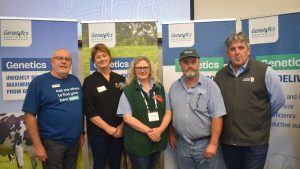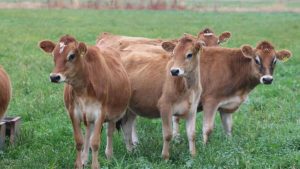
The Stewarts milk 250 registered Holsteins on Allanjay Holsteins at Newbridge, 30 kiloemetres west of Bendigo. About 140 hectares of perennial pastures and seasonal fodder crops are grown under irrigation each year for the milking herd, with an additional 120ha of dryland and another 300ha of leased land used for raising young stock and hay and silage production.
In 2015, a new 16-a-side rapid-exit dairy allowed the Stewarts to increase their herd and capitalise on their capacity to grow a lot of quality fodder. Since then, the family has set new goals to increase total farm production and profitability, focusing on genetics, herd fertility and replacement management.
By 2020, they had expanded their milking herd from 150 to 250 cows, with total farm output increasing 60 per cent from 1.15 million litres in 2015 to 1.85 million litres in the season ending June 2021. Their annual per cow milk solids production increased by 11pc from 558 kilograms to 622kg.
The Stewarts’ plan followed recommendations set out in Dairy Australia’s ‘InCalf’ handbook, and advice from nutritionists, reproduction consultants (through Murray Dairy) and their local vets.
At the time they had an old herd with poor fertility and cell count issues. “We wanted to build our herd numbers, so we looked at strategies to improve conception rates and improve our heifer management program,” Jenny said.
With conception rates sitting below 40pc, their first action was to heavily cull older cows. The income generated was then reinvested in younger genetics, utilising genomic data as part of the selection process.
“We were after young cows to replace the old ones we were culling,” Jenny said. “We wanted something better than what we already had – there’s no point in buying cows if you have something similar at home.”
For Jenny, this meant a combination of deep pedigrees with high genomic values supported by a foundation of production and type.
“I like data – I don’t like opinion,” she said. “More generations in a pedigree equals more data. More data equals more reliability – the genomics then makes everything all the more concrete.”
When selecting cows to buy, Les set a minimum target of Balanced Performance Index (BPI) +200. “We found the (genomic) results gave a pretty accurate picture of a cow’s potential,” he said. “The high BPI cows seem to consistently have a strong will to work.”
The Stewarts sourced bloodlines from top-ranking herds in the country – the Jet Star herd of Steve and Jackie Mills and Stewart and Nita McRae’s Gallrae Holsteins.
“When buying cows, we look at their BPI and their ABV [Australian Breeding Value] breakdown, as well as their PI [Production Index] and classification scores,” Les said.
“Jet Star and Gallrae had some really great cow families – cows with high BPIs, and 10 or more generations of type and production data.”
Attending the Jet Star dispersal and Harvest at Gallrae Select Sale, they selected members from the Alice, Dora, Lola (Lucky), Oriental and Chartreuse bloodlines. More recently they have added high ranking members of the Roxy and Shimmer lines to their herd.

Monitoring performance
Jenny closely monitors the herd’s genetic progress by studying the Genetic Progress Reports supplied by DataGene. “I like to see the data correlate with the overall improvements in performance,” she said.
Their August 2021 Genetic Progress Report shows the herd has an average BPI+86, ranking it at 382 out of 1280 milk recording Holstein herds in Australia for BPI. This has been a dramatic increase from 2015 when their herd averaged a BPI-1. The greatest genetic progress was in the key performance traits of fertility (now sitting at ABV +104.2), longevity (+105.8) and protein production (+13kg).
Using the Good Bulls Guide App to select their AI bulls based on profit and overall performance, the Stewarts observe the BPI and Australian Selection Index (ASI), alongside individual traits of importance. Their bull team is then run through Genetics Australia’s Genescreen program to check for inbreeding and to avoid doubling-up weaknesses in a pedigree.
“I don’t like bulls with extreme negatives. They need to have a balanced proof with no big holes,” Jenny said.
“I look for consistency – ‘cookie-cutter’ bulls – bulls where you know what you are going to get.” Fertility remains a priority, with bulls with a minimum +105 for daughter fertility along with positive scores for pin height. Rear leg rearview and udders are also important.
“I don’t like ‘hock-in’ cows. And I want udders that are high and wide at the rear and welded on at the front,” Jenny said.
Sexed Holstein semen is used over all maiden heifers, as well as a select group of milking cows based on BPI, PI and reproduction history. Conventional semen is used over the remaining herd, with the bottom BPI cows now joined to dairy beef.
“You get the most genetic gain by breeding from your heifers,” Les said. “Using sexed semen over our heifers has been the fastest way to increase our heifer numbers and is also better for calving ease.”
The Stewarts use classification through Holstein Australia to monitor their breeding program, ensuring they are meeting their targets, as well as identifying potential traits of concern. Jenny says classification provides more data to complement the genomic information and to establish an individual’s full breeding profile.
“I like knowing my breeding program is on track,” she said. “It (classification) is not just point-scoring. It is a measurement-based system – not just an ‘opinion’.”

Reaching targets
Jenny attributes a large part of their success to their commitment to reducing calf mortality and morbidity.
“This has a cumulative effect, providing more heifers to be mated to sexed semen, resulting in even more heifers the following season,” she said.
“We can then use the genomic data to select the best heifers and sell the low-end heifers to export. That way only the higher genetic merit animals enter the milking herd and breed the next generation.”
She said the extra attention to their heifer rearing and transition program had reduced their replacement rate to 25pc. This, combined with the successful use of sexed semen, has now led to a surplus in replacement stock.
In April 2021, the Stewarts selected 18 3-9 month-old heifers for export, providing an additional $20,000 income to the business. Jenny’s goal is to sell surplus heifers each year, with the additional income to be reinvested in more high-end genetics and on-farm infrastructure. She hopes to accelerate the influence of their investments in high genetic merit bloodlines through embryo transfer, while setting new targets to continue her focus on fertility.
“When we first set our target with our vet, he told us we could do it in five years – and we did,” Jenny said.





















